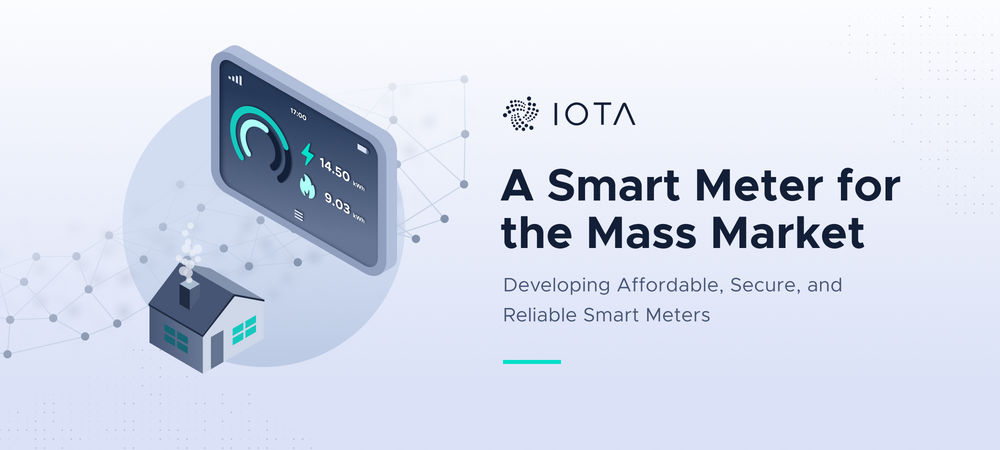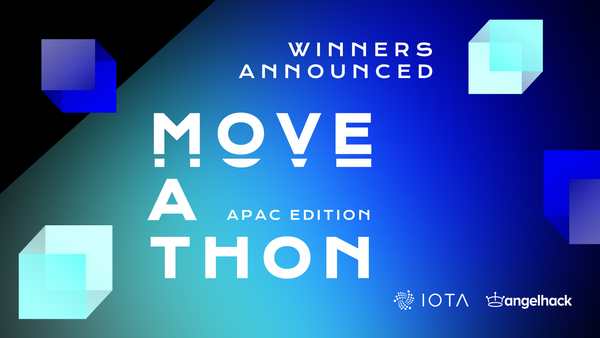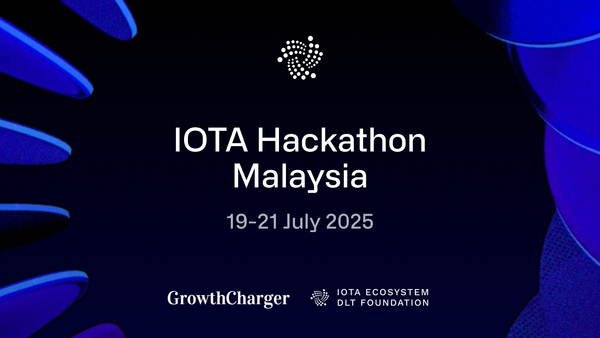SUSEE: A Smart Meter for the Mass Market
Developing Affordable, Secure, and Reliable Smart Meters
TL;DR:
The three obstacles to the widespread adoption of smart electronic energy meters are cost, data security, and reliability. As part of its work on a scalable solution for reliable and secure data transmission in sensor networks, the SUSEE project is building a mass-market low-cost wireless communication retrofit module for energy meters. Based on a Low-Power Wide-Area Network, the module uses IOTA Streams to secure the privacy and authenticity of the meter’s data to comply with strict German security laws. An initial batch of 25 test devices will be used to evaluate the product’s Proof Of Concept in the field.
Replacing regular electricity meters with smart meters is an essential first step towards an intelligent future power grid. Although smart meters have already been rolled out on a large scale in several European countries, they are still rare in Germany due to regulatory and political obstacles. Therefore, inefficient traditional meters dominate the market.
With traditional electricity meters, the consumption data has to be read manually, which is often done by the end customers themselves or by contractors of the metering point operators. In both cases, this causes additional costs. For example, notification letters have to be sent out to the customer and the status of the process has to be tracked manually (with the ensuing challenges of deadlines and unresponsive customers). Ultimately, these costs are paid by the customer via their electricity bills.
On top of the operational costs, reading electricity meters is also inconvenient for the customers, who have to deal with their energy provider's user interface and online forms. If the meter is read by a contractor of the metering point operator, not only does the customer have to be at home at the right time, but the resulting costs of hiring an operator also end up on the customer’s bill.
Smart meters simplify this process significantly:
- Meter readings are transmitted directly to the operator without the intervention of the customer or an employee of the operator. This results in cost savings and greater convenience for end customers.
- Smart meters can also be read more frequently, meaning energy suppliers can manage grid supply much more efficiently and accurately. Based on meter readings with a high temporal resolution, energy providers can offer tariffs that take into account market prices on energy exchanges, so that consumers can benefit from lower prices at specific time slots.
- Because the meter readings are processed without manual interaction there is no opportunity for human error or fraud.
Smart meters need a reliable communication channel to transmit the meter readings to the operator. This can be either a wired or a wireless connection. However, wired smart meters can only be used if the building provides the appropriate infrastructure. Therefore, in most existing buildings, wireless smart meters are used.
Cost of wireless smart meters
Until now, a major drawback of wireless smart meters has been the higher cost per unit compared to regular electricity meters, and (depending on the wireless connection technology) wireless service costs for networks like NB-IoT or LTE-M.
Connecting wireless smart meters via the LoRaWAN (short for “Low-Power Wide-Area Network") network protocol is a cost-effective solution to the problem. There are no fees for using license-free frequency bands for wireless communication, as is the case with Wifi/WLAN/IEEE802.11, NB-IoT, or LTE-M, for example. In addition, LoRaWAN is designed to work for a larger connectivity range over the air with much less energy footprint for sensor networks at scale.
LoRaWAN is a wireless communication protocol that enables long-range communications at a low bit rate among connected objects, making it ideal for edge technology. It is designed to work as a redundancy wireless networking layer, which can be seen as a supplementary wireless communication protocol alongside the upcoming 5G mobile communication networks.
As a globally-available open-source communication standard, LoRaWAN has become a popular option for building up sensor networks for Internet of Things (IoT) use cases, especially in smart cities and industrial IoT.
Data security in wireless smart meters
Another challenge facing the widespread adoption of smart meters is data security. In Germany, wireless smart meters have to meet stringent requirements in privacy, data integrity, and interoperability, as regulated by the DSGVO, the German version of the GDPR.
For example, to comply with the DSGVO, any system that processes personal data must guarantee the confidentiality of the collected data and that the data is only used for purposes necessary to fulfill the service. It must also guarantee that the end-user has explicitly consented to data collection and that this consent can be revoked at any time.
If meter data is used for fully-automated billing, smart meters need to comply with the Measuring Point Operation Act (Messstellenbetriebsgesetz) and follow the guidelines of the Federal Office for Security in Information Technology (Bundesamt für Sicherheit in der Informationstechnik).
To meet these strict security requirements, a smart meter cannot be connected using only LoRaWAN without additional protocols or security features. An application is needed on top of the LoRaWAN communication layer to fulfill the regulatory guidelines.
The SUSEE solution
Against this background, the SUSEE research project researches and designs scalable solutions for reliable and secure data transmission and processing in sensor networks. SUSEE (“Secure Sensoring Platforms for Smart Energy Grids”) is driven by a consortium of partners, namely SWO Netz GmbH, Fraunhofer FIT, Fraunhofer IPT, the University TU Chemnitz, peerOS GmbH, mCloud Systems GmbH, TIP GmbH and the IOTA Foundation.
SUSEE is developing a retrofit module for a wide range of commonly-used electronic energy meters that not only enables meter information to be read via LoRaWAN communication networks and technology but also applies to all regulatory requirements in the German market. The SUSEE Module is designed for the mass market so that the costs of components and operation must be as low as possible while meeting state-of-the-art IoT security standards and features.
From smart meters to smart grids
Beyond the tangible goal of developing the SUSEE Module, the project is seen as a springboard to explore the application of DLTs in the domain of future energy grids, known as “smart grids”. In smart grids, energy consumers can also be energy producers. These “prosumers” are complemented by energy storage used in electric vehicles or buildings. Prosumers consume or provide energy depending on current prices and price predictions, whereas the price results from current supply and demand. The more the energy supply is determined by renewable energy sources, the more the electricity price will be determined by the weather and the energy storage's state of charge.
Today's electric power grids have been designed to distribute energy mainly originating from a few powerful power plants to a large number of consumers. For future smart grids, the aim is to produce energy in many small and mid-sized decentralized renewable power plants, where electricity can be purchased, supplied, and stored by anyone.
This goal comes with some challenges. On one hand, stabilizing the voltage and frequency of the energy network while prosumers are consuming or producing energy in a very dynamic way is a challenge for regional electric power grid operators. On the other hand, data from the energy grid must be protocolled in an auditable, secure, and DSGVO-compliant way.
This data includes the amount and prices of consumed and delivered energy. Additionally, marketplaces will be needed to match buy orders and electricity offers in local areas to avoid long-distance energy flows. Fulfilled orders of delivered energy amounts at a specific price need to be protocolled so that market participants can rely on each single energy deal.
Adding IOTA to the grid
This is where the IOTA Tangle can act as a base infrastructure supplemented by reliable application protocols to manage identities, data access, and management. The technical implementation designed for IoT scenarios provides cryptographic procedures and protocols to implement audit-proof, secure, and DSGVO-compliant sensor data transmission. The IOTA Foundation is building a DLT-based IoT platform from the individual sensor on up.
Future smart energy grids will be able to profit from both IOTA Smart Contracts and IOTA’s experience in multiple smart city and decentralized finance projects. IOTA’s permissionless decentralized infrastructure will transform our energy grids into smart prosumer grids where the regulation needed to stabilize the network is balanced with the advantages of an open and decentralized economic system.
According to Dr. Andreas Baumgartner, consortium member and project coordinator of SUSEE:
The combination of IOTA’s feeless DLT-based protocol and an open-source communication protocol like LoRaWAN operating in an unlicensed frequency spectrum worldwide shows how close state-of-the-art technologies from different fields have grown together on embedded hardware and low cost, low power networking scenarios. It also shows how close this gets us to building trustworthy free-of-charge IoT services”.
Christof Gerritsma, a software engineer for the IOTA Foundation and senior developer for SUSEE, says:
The past 20 years have shown that traditional centralized Web2 solutions are ill-suited to building the consumer confidence necessary for social acceptance of public IT services. Web3 technology will give trust back to individuals, commercial players, and authorities so that they can act together in a fair and trustworthy economy. Permissionless, scalable DLTs are a fundamental base for ensuring trust in Web3 technology stacks. IOTA Streams is the Swiss army knife needed to implement DSGVO- compliant applications in Web3”.
How IOTA Streams is used
IOTA Streams is a second-layer application protocol built on top of IOTA that enables structured data transmissions and manages access rights for all transmission participants.
It provides secure cryptographic algorithms that protect data against unauthorized access, authenticates participants, and signs the transferred messages by the participants. In combination with the IOTA protocol, all messages can be stored in a tamper-proof, decentralized system.
To meet DSGVO requirements, IOTA Streams is used in the SUSEE Module to add security to the wireless LoRaWAN connection. The data of each energy meter is transferred through a dedicated data stream so that the access rights for both roles – publishers and subscribers – can be controlled by an administrator.
To provide maximum data security on top of LoRaWAN’s inherent security features, the meter’s data is wrapped into Streams packages directly in the SUSEE Module. Securing data with IOTA Streams directly in a LoRaWAN-connected sensor means pushing authentication and authorization to the edge of IoT communication in an unlicensed frequency spectrum and therefore to the edge of embedded systems. Securing data directly at the source is always the safest solution.

Data is transmitted from the energy meter to the SUSEE Module via a serial interface. As both the meter and the SUSEE Module are enclosed in a sealed casing, data corruption is impossible at this stage without breaking the seal. Within the SUSEE Module, data is encrypted and signed using IOTA Streams. The encrypted data packets can now be sent over the LoRaWAN network. In the LoRaWAN application server, an IOTA Bridge is used to attach the encrypted packages to the IOTA Tangle. In most existing solutions, when IOTA Streams is used with LoRaWAN for sensor data transmission, the sensor data is encrypted and signed with Streams on the LoRaWAN application server, thereby missing critical security-related capabilities regarding tamper-proof identities for IoT devices.

Although the sensor data is also protected during radio transmission by LoRaWAN's own encryption and authentication, the disadvantage here is that the sensor data is unencrypted on the LoRaWAN application server. With the SUSEE architecture, however, meter data already reaches the application server as encrypted Streams packages. The maintenance of these systems does not require additional data protection, which results in lower maintenance costs for these systems.
Encrypting and signing the meter data directly in the SUSEE Module can also be used to provide a stand-alone administration website (similar to well-known examples by many routers) that can be used to manage access rights for the meter data or revokes the consent to data usage as required by the DSGVO. As IOTA Streams manages access rights management by data encryption on the IoT device itself, the customer does not have to rely on the service provider to correctly implement the rights management.
As IOTA Streams is currently used in the development of 14 international projects with major corporate, academic, and association partners (including Dell), the reliability of the library is matured in a broad spectrum of use cases and applications. For more information about the projects already using IOTA Streams, search the IOTA Lighthouse Projects dashboard with the filter set to "Streams”.
Using IOTA Streams on a device designed for the mass market means operating it on low-cost microcontrollers with limited memory and CPU resources. Here, the SUSEE consortium has opted for the ESP32-C3 of Espressif Systems. As the Streams library is written in RUST and the functionality needed for the SUSEE Module could not be achieved by using Streams C/C++ bindings, the proof of concept implementation for the Streams processes in the SUSEE Module is completely written in RUST as well. Thanks to the emerging embedded RUST and especially the esp-rs community projects, the available RUST code of the Streams library can be used directly on the ESP32-C3 microcontroller. This is the first time that Streams is used on an ESP32-C3 microcontroller.
One of the main challenges in sending encrypted data packages via LoRaWAN is the package size because LoRaWAN is very limited in that regard. That said, choosing cryptographic algorithms that offer a minimized package size encryption overhead is important. The foresighted selection of IoT-suitable and state-of-the-art algorithms in the IOTA Streams library pays off greatly. Compared to the formerly used MAM library, the package sizes could be reduced by approximately 75%.
Field testing the technology
The hardware for a proof-of-concept SUSEE Module has been designed and is currently manufactured in an initial batch of 25 devices. As soon as the hardware is available, the transmission characteristics of the LoRaWAN communication will be evaluated in field tests. These tests will be run together with the Stadtwerke Osnabrück in the city of Osnabrück where a LoRaWAN network coverage of more than 40 gateways allows access to meters in the cellars of houses.
The tests and measurements of the field test campaign will be accompanied by simulations of multiple transmission scenarios. These simulations allow varying major properties of a transmission setup (such as the number of connected devices, the characteristics of the built-up area, and different LoRaWAN configurations) and use cases to evaluate the overall system performance and to derive initial guidelines for gateway placement and network planning strategies. Additionally, the field test campaign will be the first real-life proof of the system’s application transport layer that uses IOTA Streams to ensure data security in cooperation with underlying communication layers, such as LoRaWAN.
In preparation for the field tests of the SUSEE Module hardware POC, a pre-test will be performed using available standard development boards that will be assembled into a batch of test systems. This pre-test allows us to evaluate the main characteristics of the software and hardware design as well as the execution of early LoRaWAN field tests and to test the network performance in real life.
Summary
Wireless smart meters greatly simplify meter reading and thus provide cost savings and greater convenience for end customers. Despite these advantages, they are still rare in Germany due to regulatory obstacles and higher costs. To tackle these challenges, the SUSEE consortium is developing a retrofit module for commonly-used electronic energy meters, which enables meter data to be read via LoRaWAN communication networks and applies to all German regulatory requirements. The SUSEE Module will be a cost-effective solution for the German market, achieved by using low-cost hardware that reduces the price per unit and by using the LoRaWAN network protocol, which allows feeless use of license-free frequency bands for wireless communication.
Smart meters are a first step to transforming traditional electric energy grids into smart grids, which consist of many small and mid-sized prosumers and where electricity can be purchased, supplied, and stored by anyone. To facilitate the data management of future decentralized energy marketplaces, the SUSEE Module sends the meter readings using the IOTA Tangle, which acts as a base infrastructure to manage the relevant data in an auditable, secure, and DSGVO-compliant way.
To meet stringent German requirements for privacy and data integrity, IOTA Streams is used to manage identities, data access, and management. Without IOTA Streams, wireless smart meter communication via LoRaWAN would not meet German regulatory requirements. Detailed information about IOTA Streams can be found in the official Streams documentation.
To provide maximum data security on top of LoRaWAN’s inherent security features, IOTA Streams is used directly in the data source – the SUSEE Module. To realize the usage of IOTA Streams on the low-cost microcontroller ESP32-C3, the RUST sources of the Streams libraries have been compiled for the ESP32-C3 platform, which is a technical novelty.
The proof of concept hardware of the SUSEE Module and its LoRaWAN transmission characteristics will be evaluated in field tests in Osnabrück. The tests will be accompanied by simulations of varying major transmission setup properties. The results of the tests and the latest status of the project will be the subject of our next SUSEE update blog post.
Currently, all project partners are focused on the primary project goals and technical challenges that come with the ongoing pre-test and the field test. At a later stage, when the final product becomes more tangible, there will be more of a focus on publicizing the project – watch this space!




